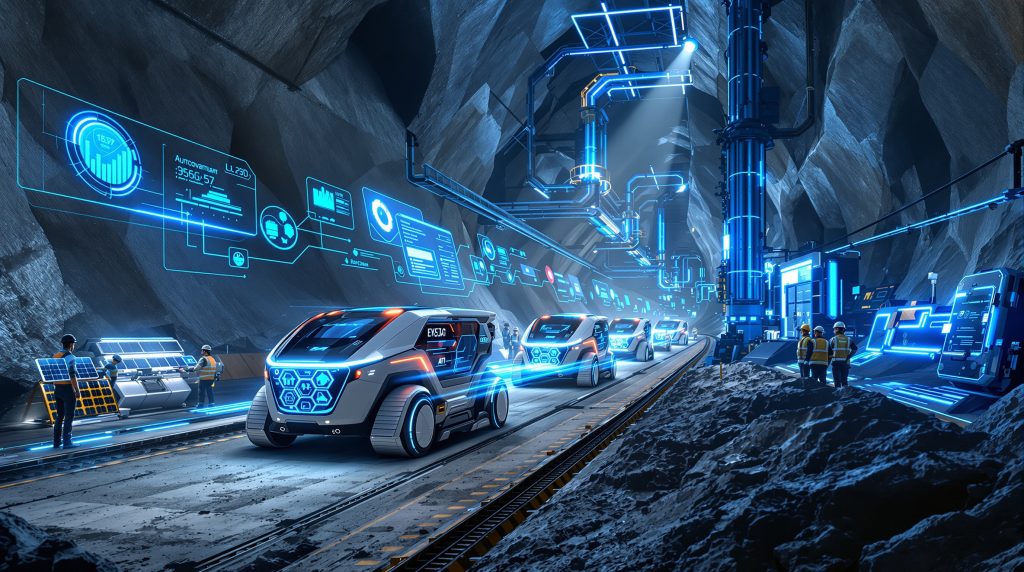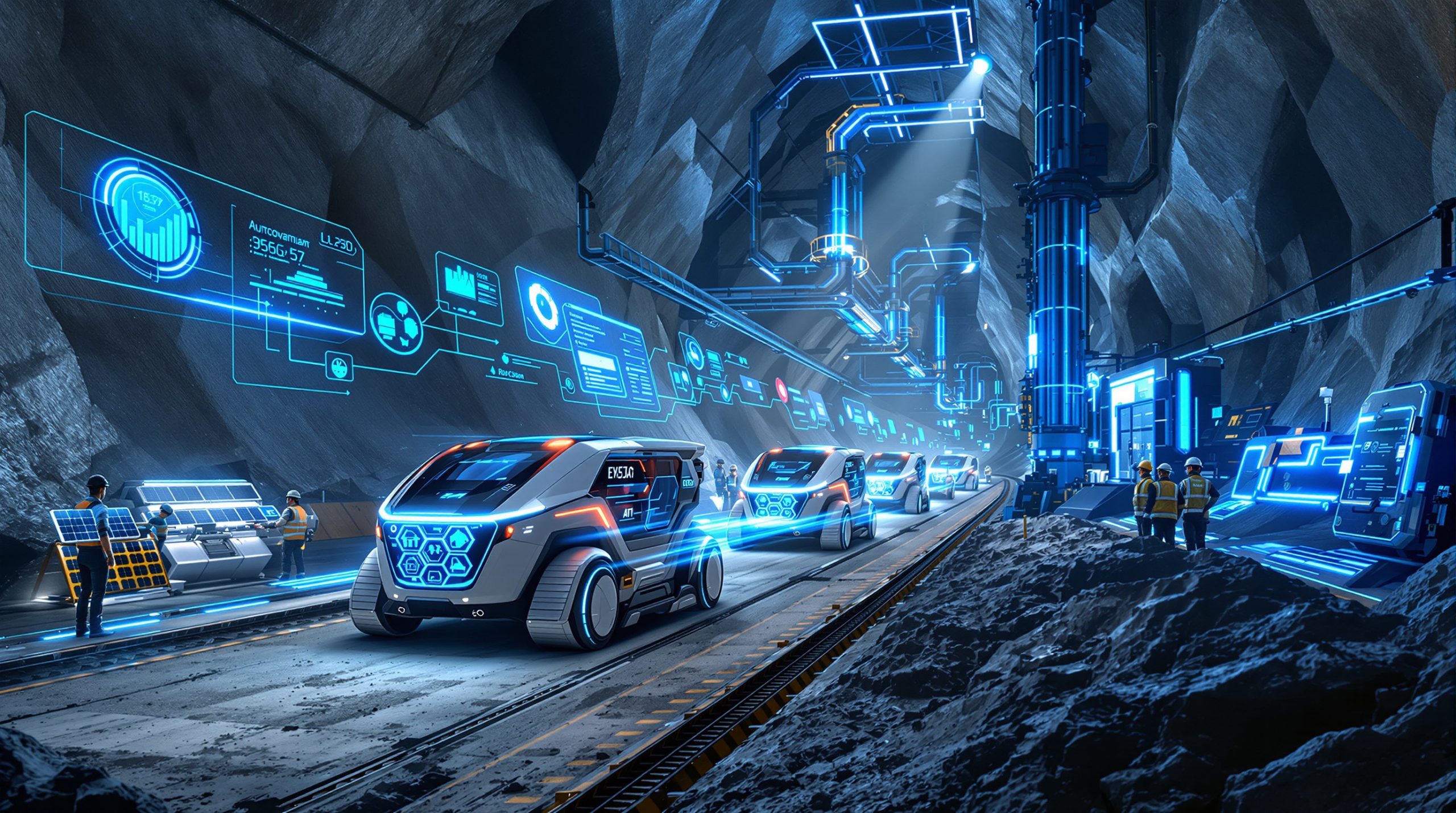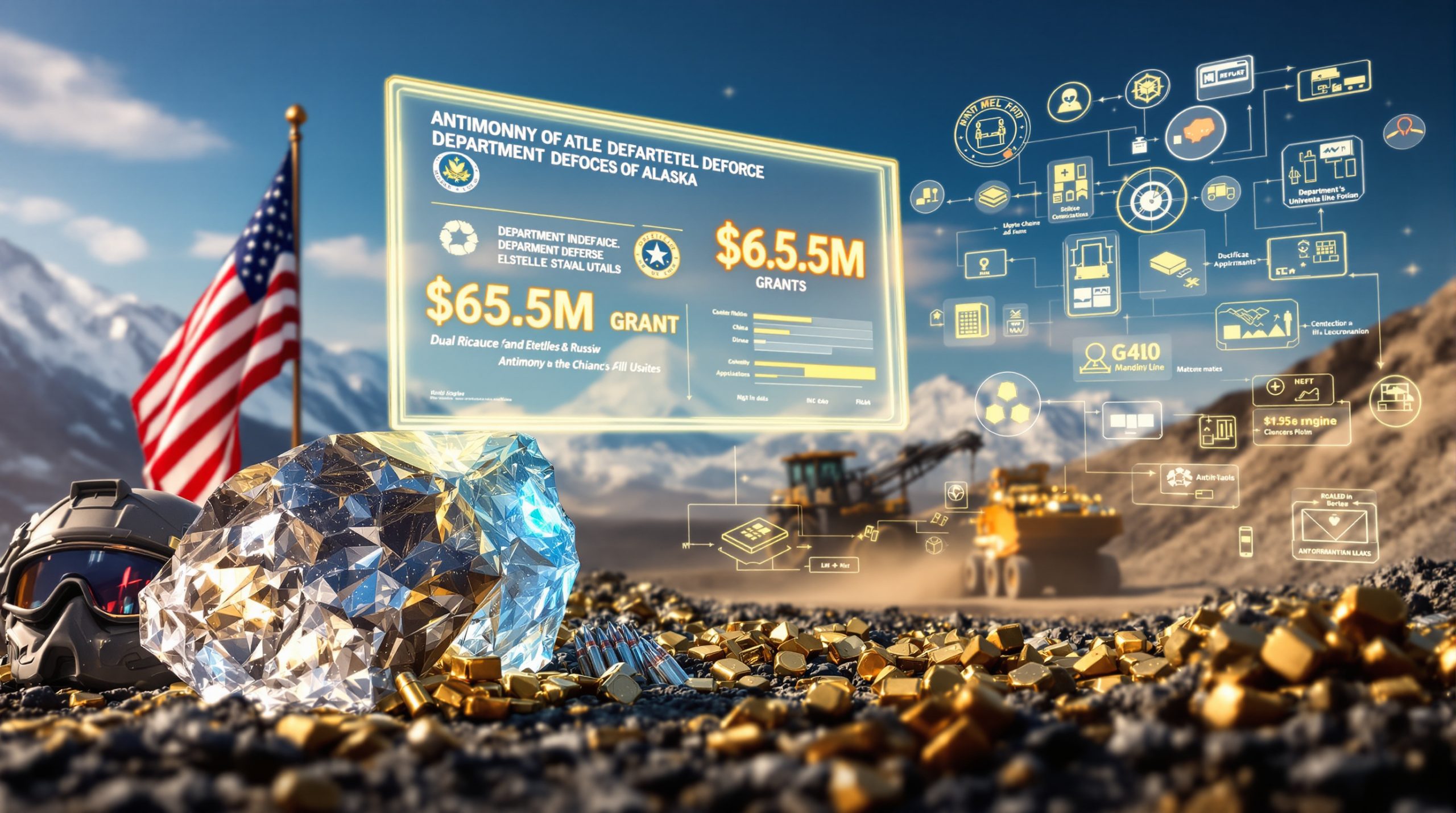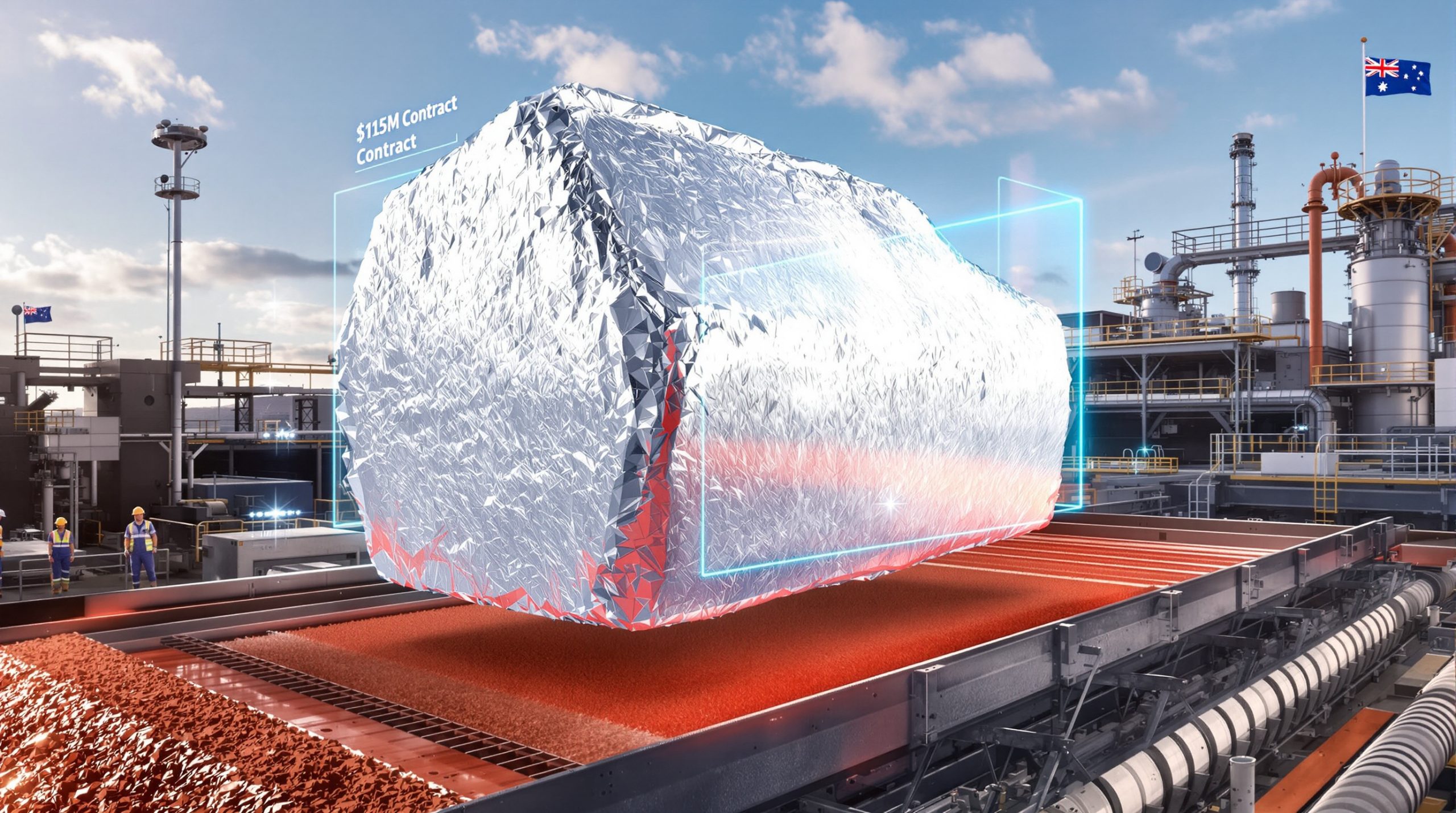Funding the Mine of the Future: Strategic Investment Approaches for Modern Mining
How Is the Mine of the Future Being Defined?
The concept of mining's future is undergoing a profound transformation, moving well beyond traditional extraction methods to embrace a technology-driven paradigm. Today's mining operations increasingly integrate cutting-edge innovations while maintaining a careful balance between resource recovery and environmental stewardship.
Modern mining facilities are rapidly evolving from labor-intensive operations into sophisticated technology hubs where digital systems coordinate with physical infrastructure. This evolution represents a fundamental shift in how mining companies approach resource extraction, processing, and sustainability.
The Evolution of Modern Mining Concepts
The mining industry stands at a pivotal crossroads, transitioning from conventional extraction techniques to operations powered by advanced technology. This shift incorporates autonomous systems, artificial intelligence, and robotics, all designed to enhance efficiency while reducing environmental impacts.
Industry leaders are prioritizing technologies that minimize disruption to landscapes while maximizing resource recovery rates. This dual focus has driven industry innovation trends in areas like precision drilling, advanced sensing technologies, and waste reduction systems.
Remote operations centers now allow mining companies to monitor and control equipment from hundreds or thousands of miles away, dramatically improving worker safety by removing personnel from hazardous environments. These technologies are rapidly becoming industry standards rather than experimental approaches.
Key Characteristics of Future Mining Operations
The mine of the future funding is characterized by several defining elements that distinguish it from traditional operations. Zero or near-zero emissions equipment forms a cornerstone of this vision, with battery-electric vehicles and hydrogen-powered machinery replacing diesel fleets.
Digital twins—virtual replicas of physical mining operations—allow companies to simulate changes, predict maintenance needs, and optimize processes before implementation. These systems can reduce unplanned downtime by up to 25% while extending equipment lifespans significantly.
Advanced ore sorting technologies now enable miners to identify valuable minerals earlier in the extraction process, reducing energy consumption by processing only high-value material. This represents a fundamental shift from bulk mining approaches that process all extracted material regardless of quality.
In-situ recovery methods are gaining prominence, particularly for certain minerals. These techniques extract resources directly from deposits without traditional mining, significantly reducing surface disturbance. The Department of Energy has specifically highlighted this approach in its funding programs, citing the Florence copper mine as a practical example of in-situ technology deployment.
Water conservation technologies, including closed-loop systems that recycle virtually all process water, are becoming standard in regions facing water scarcity. These systems not only reduce environmental impact but also lower operational costs and regulatory risks.
What Major Funding Initiatives Are Supporting Mining Innovation?
The financial landscape for mining innovation has expanded dramatically in recent years, with government agencies, private industry, and international organizations committing substantial resources to modernize the sector. These investments reflect growing recognition of mining's essential role in providing materials for renewable energy and other advanced technologies.
The US Department of Energy's $95 Million Investment
In a landmark initiative, the US Department of Energy announced a $95 million funding package specifically targeting "Mine of the Future" research programs. This investment allocates $80 million for modernizing mining technologies across four demonstration sites designated as "proving grounds" for testing and scaling new mining approaches.
These demonstration sites will serve as real-world laboratories where companies can validate technologies before full commercial deployment. This approach reduces risk for both technology developers and mining operators by providing a middle ground between laboratory testing and full-scale implementation.
The program places special emphasis on in-situ recovery methods, which extract resources directly from deposits without traditional mining. The Florence copper mine has been highlighted as a practical example of this technology, demonstrating how in-situ approaches can reduce surface disruption while maintaining economic viability.
Critical minerals essential for clean energy technologies receive particular attention in this funding initiative. The program recognizes that securing domestic supplies of materials like lithium, cobalt, and rare earth elements requires both expanding production and developing more sustainable extraction methods.
International Government Funding Programs
Beyond the United States, numerous countries have established funding programs to drive mining innovation. The Canadian Clean Growth Program provides substantial resources for projects that reduce environmental impacts while improving productivity in the resources sector.
The European Union's Horizon Europe program includes significant funding for sustainable resource extraction as part of its broader climate and sustainability goals. These investments focus particularly on technologies that can reduce the carbon footprint of mining operations while securing material supply chains critical to European industry.
Australia, with its resource-dependent economy, has implemented several government initiatives promoting mining technology innovation. The Australian Renewable Energy Agency has specifically funded projects integrating renewable energy into mining operations, recognizing the substantial emissions reduction potential in this sector.
Public-private partnerships have emerged as a particularly effective model for accelerating technology adoption. These arrangements leverage government funding to reduce risk while drawing on private sector expertise to ensure commercial viability, creating a powerful combination for driving innovation.
Industry-Led Investment Consortiums
Beyond government funding, mining companies themselves are increasingly pooling resources to solve common challenges. These industry consortiums allow competitors to share research and development costs for pre-competitive technologies, accelerating innovation while reducing financial risk for individual companies.
Technology incubators focused specifically on mining solutions have proliferated in major mining regions. These organizations provide funding, expertise, and connections to help startups develop and commercialize innovations specifically for the mining sector.
Venture capital interest in mining technology has grown substantially, with investment increasing by approximately 45% since 2023. This influx of private capital reflects growing recognition of the profit potential in technologies that can reduce costs and improve sustainability in mining operations.
Cross-industry partnerships between mining, technology, and energy companies are creating particularly innovative solutions. These collaborations bring diverse expertise to complex challenges, resulting in breakthroughs that might not emerge from any single sector working alone.
How Are ESG Considerations Shaping Investment Strategies?
Environmental, social, and governance (ESG) factors have moved from peripheral concerns to central considerations in mining investment decisions. This shift reflects both regulatory pressures and market realities, as downstream customers increasingly demand responsibly sourced materials.
The Rise of ESG-Linked Financing Models
ESG-linked financing has emerged as a powerful tool for driving sustainable practices in mining. Industry analysts project a 35% increase in ESG-linked financing for mining projects by 2025, reflecting growing market acceptance of these structures.
Performance-based interest rates tied to sustainability metrics now feature in many mining finance packages. These instruments create direct financial incentives for improving environmental and social performance, with companies achieving sustainability targets earning lower interest rates.
Carbon reduction commitments increasingly appear as prerequisites for accessing certain funding sources. Institutional investors and banks with net-zero commitments are screening mining projects carefully, requiring clear decarbonization pathways before providing capital.
Community development obligations have become integrated into financing structures for many mining projects. These provisions ensure that local communities share in the benefits of resource development while providing mining companies with stronger social licenses to operate.
Investor Expectations for Sustainable Mining
Institutional investors, who control trillions in investable assets, increasingly prioritize mining companies with clear decarbonization roadmaps. These investors recognize both the climate risks and transition opportunities facing the mining sector, and are allocating capital accordingly.
Shareholder activism has become a powerful force driving adoption of stricter environmental standards. Mining companies face growing pressure from their investors to improve performance on issues ranging from tailings management to biodiversity protection.
Downstream markets increasingly apply premiums for responsibly sourced minerals. This trend has created tangible financial incentives for mining companies to invest in sustainability, as customers in sectors from electronics to automotive demonstrate willingness to pay more for materials with lower environmental and social impacts.
Transparency requirements for environmental and social impact reporting continue to expand. Mining companies now face expectations to provide detailed, standardized disclosures on their sustainability performance, creating reputational and market access risks for laggards.
Balancing Profitability with Sustainability Goals
Mining companies face the complex challenge of balancing sustainability investments with financial performance. Sophisticated cost-benefit analyses have become essential tools for evaluating sustainable mining technologies, helping companies identify solutions that deliver both environmental and economic benefits.
Long-term ROI calculations increasingly incorporate carbon pricing scenarios. This approach allows mining companies to make investment decisions that account for future regulatory developments, potentially avoiding stranded assets as climate policies tighten.
Early adopters of green mining practices are discovering competitive advantages beyond regulatory compliance. These benefits include lower operating costs, improved community relations, and preferential access to certain markets and capital sources.
Risk mitigation through environmental and social governance excellence has become a core strategy for leading mining companies. These organizations recognize that proactive sustainability management reduces regulatory, reputational, and operational risks, creating long-term value for shareholders.
What Innovative Funding Models Are Emerging?
The capital-intensive nature of mining, combined with the technological transformation underway, has spawned creative financing approaches tailored to the industry's unique needs. These innovative models help distribute risk while ensuring capital flows to promising technologies.
Project Finance Structures for Mining Innovation
Off-balance-sheet financing solutions have emerged for major mining transformations, allowing companies to pursue innovation without burdening their core balance sheets. These structures can be particularly valuable for companies transitioning existing operations to new technologies.
Risk-sharing mechanisms between technology providers and mining companies help align incentives while distributing financial exposure. Under these arrangements, technology providers may accept partial payment based on achieved performance improvements, reducing the mining company's upfront investment risk.
Staged funding approaches tied to technology performance milestones have become common for major innovation projects. This approach allows capital to flow as technologies prove themselves, reducing risk for financiers while ensuring continued support for successful innovations.
Special purpose vehicles dedicated to mining innovation projects provide flexible structures for combining capital from various sources. These entities can include mining companies, technology providers, financial institutions, and government agencies, creating purpose-built funding mechanisms for specific innovation initiatives.
Technology Licensing and Royalty Arrangements
Intellectual property monetization strategies have evolved to support mining technology developers. These approaches allow smaller companies to commercialize innovations without the capital required to implement them directly, expanding the innovation ecosystem.
Performance-based royalty structures for technology implementation create win-win arrangements where technology providers earn returns based on the value they create. This alignment of incentives encourages ongoing support and improvement of deployed technologies.
Cross-licensing arrangements between mining innovation companies help spread valuable technologies while reducing transaction costs. These agreements allow multiple companies to benefit from each other's innovations without complex negotiation for each technology transfer.
Formalized technology transfer models from research institutions to mining operations help bridge the gap between academic research and commercial application. These models provide clear pathways for innovations developed in laboratories to reach practical implementation in mining operations.
Alternative Capital Sources
Crowdfunding platforms have emerged for smaller-scale mining innovation projects, particularly those with environmental or social benefits. These platforms connect mining innovators directly with investors interested in supporting sustainable resource development.
Mineral streaming agreements, traditionally used for production financing, have evolved to fund technology implementation. Under these arrangements, investors provide capital for technology deployment in exchange for rights to purchase a portion of future mineral production at predetermined prices.
Equipment leasing models for next-generation mining machinery help companies access advanced technology without large upfront capital expenditures. These arrangements can be particularly valuable for smaller mining operations with limited balance sheet capacity.
Green bonds specifically targeting mining transition projects have grown in popularity as sustainable finance markets mature. These instruments connect mining companies implementing significant sustainability improvements with investors seeking environmentally positive outcomes.
What Technologies Are Attracting the Most Investment?
Investment capital in mining innovation tends to concentrate around technologies offering the most compelling combinations of economic returns and sustainability benefits. Several technology categories have emerged as particular magnets for funding.
In-Situ Recovery Methods
Dissolution-based extraction technologies that minimize surface disturbance have attracted substantial investment. These approaches dissolve target minerals underground and pump the solution to the surface, dramatically reducing the physical footprint of mining operations.
The Department of Energy's funding program has specifically targeted in-situ copper recovery demonstration projects. This focus reflects the potential of in-situ techniques to transform copper production, a critical metal for renewable energy and electrification.
Bioengineered leaching solutions utilizing specialized microorganisms to extract minerals have shown particular promise for certain deposit types. These technologies leverage natural processes to dissolve target minerals while potentially reducing chemical usage.
Advanced environmental monitoring systems for groundwater protection have become essential companions to in-situ recovery methods. These technologies provide real-time data on groundwater conditions, ensuring that extraction processes do not compromise water resources.
Autonomous Mining Systems
Self-driving haulage and drilling equipment has attracted major investment from both mining companies and technology providers. These systems improve safety by removing operators from hazardous environments while increasing productivity through 24/7 operation.
Remote operations centers controlling multiple mine sites have become reality for several major mining companies. These facilities allow skilled operators to monitor and control equipment across a global portfolio of assets, optimizing expertise utilization while reducing travel requirements.
AI-powered decision support systems for mine planning have progressed from theoretical concepts to practical tools. These technologies analyze vast quantities of geological, operational, and market data to optimize extraction sequences and processing approaches.
Drone and robotic systems for inspection and maintenance tasks reduce human exposure to hazardous environments while improving data collection. These technologies can access areas difficult for human workers to reach, providing detailed visual and sensor information to inform maintenance decisions.
Energy Transition Technologies for Mining
Battery electric vehicle fleets replacing diesel equipment have become a major focus for mining companies seeking to reduce emissions. These technologies eliminate exhaust emissions in underground environments while potentially reducing operating costs through lower maintenance requirements.
Renewable energy microgrids powering remote mining operations have moved from experimental projects to mainstream solutions in many regions. These systems combine solar, wind, and battery storage to reduce or eliminate diesel generation at isolated mine sites.
Hydrogen fuel cell applications for heavy mining equipment are advancing rapidly, particularly for machines requiring high energy density. Several major manufacturers now offer hydrogen-powered options for mining equipment, providing zero-emission alternatives for the most energy-intensive applications.
Energy storage solutions balancing intermittent power sources have become essential components of mining energy systems. These technologies enable higher renewable energy penetration by managing supply-demand mismatches, potentially transforming the energy profile of remote mining operations.
How Are Mining Companies Allocating Innovation Budgets?
The distribution of innovation spending reveals much about mining companies' priorities and strategies. While allocations vary by company and commodity, certain patterns have emerged across the industry.
Strategic Investment Priorities
Digital transformation initiatives typically capture approximately 40% of innovation budgets at major mining companies. This substantial allocation reflects the foundational role of digital systems in enabling other innovations, from autonomous equipment to predictive maintenance.
Decarbonization projects generally receive around 35% of technology investment. This significant allocation demonstrates mining companies' recognition of both the regulatory pressures and potential competitive advantages associated with reducing carbon emissions.
Water management solutions usually secure about 15% of environmental spending. This allocation reflects the critical importance of water as both an operational necessity and a potential point of conflict with local communities and regulators.
Safety and automation technologies consistently receive substantial capital expenditure across the industry. These investments deliver the dual benefits of protecting workers while improving operational efficiency, making them priorities even in challenging economic environments.
ROI Expectations and Measurement
Productivity gains of 15-30% typically justify automation investments in mining operations. These improvements come through increased utilization, higher operating speeds, and reduced variability in performance, creating compelling business cases for automation technologies.
Energy cost reductions of 20-40% from renewable integration have been demonstrated at numerous mining operations. These savings, combined with reduced exposure to fuel price volatility, create strong financial incentives for renewable energy adoption.
Extended equipment life through predictive maintenance represents a significant value driver for digital investments. By identifying maintenance needs before catastrophic failures occur, these systems can add years to the useful life of expensive mining equipment.
Reduced environmental liability through improved waste management delivers financial benefits beyond compliance. Mining companies increasingly recognize that superior waste management reduces long-term closure costs while protecting the company's reputation and social license.
Balancing Near-Term and Long-Term Innovation
Quick-win technology implementations delivering immediate returns typically comprise about half of innovation portfolios. These projects help maintain support for innovation programs by demonstrating tangible benefits while more transformative technologies develop.
Moonshot projects addressing fundamental mining challenges usually receive smaller but consistent funding. These higher-risk, higher-reward initiatives explore potentially transformative approaches like waterless processing or continuous hard rock mining.
Staged innovation roadmaps with clear investment milestones help companies manage technology risk while maintaining momentum. These plans establish decision points for continuing, adjusting, or abandoning projects based on demonstrated results.
Portfolio approaches spreading risk across multiple technologies have become standard practice among sophisticated mining innovators. This diversity of approaches increases the likelihood of success while providing multiple pathways to address critical challenges.
What Challenges Must Be Overcome to Secure Funding?
Despite growing interest in mining innovation, securing capital for new technologies remains challenging. Several significant barriers must typically be overcome to move promising ideas from concept to implementation.
Technical Risk Assessment
Proving technology readiness levels for novel mining approaches presents a particular challenge. Investors and mining companies typically require demonstration at progressively larger scales, creating a "valley of death" between laboratory success and commercial implementation.
Scale-up challenges from laboratory to commercial implementation have derailed many promising mining technologies. Physical processes that work perfectly at small scale may encounter unexpected complications when applied to the volumes and heterogeneity of commercial mining operations.
Site-specific adaptation requirements for new technologies complicate investment decisions. Mining conditions vary dramatically between operations, often necessitating substantial modification to technologies before they can be applied in new contexts.
Integration with existing mining infrastructure and systems presents both technical and financial challenges. Few mining operations can implement entirely new technological systems; most must find ways to incorporate innovations into established operations with legacy equipment and processes.
Economic Barriers
High capital costs for first-of-kind technology implementations deter many potential early adopters. Without proven performance at commercial scale, these projects carry substantial financial risk, making funding difficult to secure despite potential benefits.
Uncertain payback periods for transformative technologies complicate traditional investment analysis. Technologies that could fundamentally change mining approaches may deliver benefits over decades, making standard discounted cash flow analysis less applicable.
Competition for capital within mining company portfolios remains intense. Innovation projects must compete with mine expansions, equipment replacements, and other investments with more predictable returns, often placing them at a disadvantage in capital allocation processes.
Volatility in mineral markets affects investment decisions for long-term innovation projects. During price downturns, innovation budgets frequently face cuts as companies focus on short-term survival, creating boom-bust cycles in technology development.
Regulatory and Policy Considerations
Permitting frameworks for novel extraction methods often lag behind technological development. Regulatory agencies may lack clear processes for evaluating new approaches, creating uncertainty and delays for innovative projects.
Tax incentives and subsidies for mining innovation vary widely between jurisdictions. This inconsistency creates uneven playing fields for technology developers and may concentrate innovation in regions with more supportive policy environments.
International standards for sustainable mining practices continue to evolve, affecting the value proposition for many innovations. Technologies designed for current requirements may face obsolescence if standards change significantly during development cycles.
Government procurement policies for critical minerals increasingly influence technology choices. As nations prioritize secure supply chains for strategic materials, technologies enabling domestic production of these minerals may receive preferential treatment regardless of other attributes.
How Are Successful Mining Innovation Projects Structured?
Examining successful innovation implementations reveals common structural elements that increase the likelihood of positive outcomes. These patterns provide valuable guidance for designing future projects.
Case Studies of Effective Implementation
Battery electric vehicle transitions at underground mines have demonstrated ventilation cost reductions of approximately 30%. These savings result from eliminating diesel exhaust, allowing mines to reduce expensive ventilation infrastructure while improving working conditions.
Autonomous haulage systems have consistently increased productivity by around 20% while improving safety records. These gains come through 24/7 operation, optimized routing, and elimination of shift changes and operator breaks, creating compelling business cases despite substantial implementation costs.
Renewable energy integration has reduced operating costs significantly at remote mining operations. Several mines in Australia and Chile have achieved 60-80% renewable penetration, dramatically reducing diesel consumption and associated logistics costs.
Digital twins have enabled predictive maintenance approaches that reduce downtime by approximately 25%. By identifying potential failures before they occur, these systems allow planned maintenance interventions rather than emergency repairs, improving equipment availability while extending asset life.
Key Success Factors
Strong executive sponsorship and clear innovation mandates distinguish successful mining technology implementations. Without committed leadership, promising projects often stall when facing inevitable technical or organizational challenges.
Cross-functional teams combining mining and technology expertise prove essential for bridging the gap between theoretical potential and practical implementation. These integrated teams help ensure that innovations address real operational needs while remaining technically feasible.
Phased implementation approaches with defined success metrics allow companies to manage risk while building organizational capability. This graduated approach provides opportunities to adjust course based on actual results rather than committing entirely to unproven technologies.
Collaborative partnerships with technology providers and research institutions expand the capabilities available to mining innovators. These relationships bring specialized expertise to mining challenges while distributing development costs and risks among multiple stakeholders.
Risk Mitigation Strategies
Technology demonstration projects before full-scale implementation have become standard practice for mining innovation. These smaller deployments allow testing under real operating conditions without the financial exposure of fleet-wide implementation.
Parallel development of multiple solution pathways provides insurance against the failure of any single approach. This portfolio strategy recognizes the inherent uncertainty in innovation while maintaining progress toward important objectives.
Flexible implementation timelines accommodating technology evolution prevent companies from being locked into obsolete solutions. This adaptability allows incorporation of improvements that emerge during extended implementation periods.
Comprehensive stakeholder engagement throughout innovation processes helps identify and address concerns that might otherwise derail projects. Early involvement of operators, maintainers, communities, and regulators creates broader support while improving designs through diverse feedback.
What Future Trends Will Shape Mining Investment?
Emerging developments in technology, markets, and regulation are creating new investment opportunities while reshaping established approaches. Several key trends will likely influence mining innovation funding in coming years.
Emerging Funding Mechanisms
Carbon credit generation from mining decarbonization projects has emerged as a potential supplementary revenue stream. As carbon markets mature, mining companies implementing significant emissions reductions may monetize these improvements through credit sales.
Blockchain-based mineral provenance verification systems are creating premium pricing opportunities for responsibly sourced materials. These technologies provide transparent, immutable records of mineral origins and processing, allowing verification of environmental and social performance.
Circular economy business models for mining waste valorization are attracting increased investment. Technologies that convert tailings and waste rock into valuable products can transform environmental liabilities into revenue sources while reducing long-term closure costs.
Community co-investment in sustainable mining operations has shown promise for strengthening social license. These models allow local stakeholders to share directly in project economics, aligning interests between mining companies and host communities.
Shifting Investment Priorities
Increasing focus on mineral processing innovation reflects recognition of its outsized environmental impact. Technologies that reduce energy and water consumption in processing can deliver substantial sustainability benefits while improving cost structures.
Growing interest in urban mining and recycling technologies acknowledges the potential of secondary sources to supplement primary production. As virgin ore grades decline and waste volumes grow, technologies enabling resource recovery from existing materials become increasingly attractive.
Rising importance of social license considerations in funding decisions reflects awareness of project risks beyond technical and financial factors. Investors increasingly recognize that community opposition can delay or halt even technically sound projects, making social performance a critical factor.
Integration of mining with renewable energy development creates synergies between resource extraction and clean energy production. Mining operations with access to land and infrastructure may develop energy resources exceeding their own needs, creating additional revenue streams.
The Evolving Regulatory Landscape
Carbon border adjustment mechanisms being implemented in several jurisdictions will affect mining economics. These policies impose carbon costs on imported materials, potentially creating competitive advantages for producers with lower emissions intensities.
Extended producer responsibility regulations increasingly drive recycling investments throughout mineral value chains. These requirements make manufacturers responsible for end-of-life product management, creating incentives for recyclability and recycled content.
Stricter water use regulations influence technology choices in many mining regions. As competition for water resources intensifies, technologies enabling reduced consumption or utilization of non-traditional water sources become increasingly valuable.
Indigenous rights considerations have become central to mining project development in many regions. Recognition of traditional ownership and authority has created both challenges and opportunities for mining development, with successful projects developing genuine partnerships with indigenous communities.
How Can Mining Companies Prepare for Future Funding Opportunities?
Positioning to capitalize on emerging funding sources requires strategic preparation. Companies can take several concrete steps to improve their access to capital for innovation projects.
Building Compelling Investment Cases
Quantifying both financial and non-financial benefits of mining innovation strengthens investment cases. Comprehensive analysis addressing productivity, sustainability, risk reduction, and strategic positioning helps justify capital allocation to innovation projects.
Developing clear technology roadmaps with implementation milestones demonstrates a structured approach to innovation. These plans show investors how individual projects fit into broader strategic objectives, creating coherence across diverse innovation initiatives.
Demonstrating alignment with global sustainability frameworks like the UN Sustainable Development Goals has become increasingly important for accessing certain funding sources. This alignment shows how innovation projects contribute to broader societal objectives beyond company-specific benefits.
Highlighting critical mineral supply security benefits can attract both government and private funding. As nations prioritize secure supply chains for materials essential to energy transition and national security, projects addressing these needs may access dedicated funding streams.
Strategic Partnership Development
Collaborating with research institutions on technology development leverages specialized expertise while sharing costs. These partnerships provide access to cutting-edge knowledge while distributing financial risk between academic and commercial entities.
Engaging with equipment manufacturers on co-development projects aligns incentives throughout the innovation pipeline. These arrangements ensure that innovations address practical implementation challenges while providing clear commercialization pathways.
Forming consortiums to share technology development costs has proven effective for addressing pre-competitive challenges. These collaborative structures allow companies to pool resources on innovations that benefit the entire industry without creating competitive disadvantages.
Building relationships with specialized mining technology investors helps companies access capital attuned to the industry's unique characteristics. These investors understand mining cycles, technical challenges, and value creation opportunities better than generalist funding sources.
Talent and Capability Building
Developing internal expertise in emerging mining technologies enables better investment decisions. Teams with deep understanding of technological possibilities and limitations can identify the most promising opportunities while avoiding costly missteps.
Creating innovation hubs to attract specialized talent concentrates capabilities in environments conducive to creative problem-solving. These structures provide the focused resources and collaborative environments needed to address complex mining challenges.
Establishing technology scouting capabilities helps companies identify emerging opportunities before they become widely recognized. This early awareness allows engagement with promising technologies while valuations remain reasonable and partnership opportunities abound.
Building project management capabilities for complex innovation initiatives improves implementation success rates. The unique challenges of mining innovation—technical uncertainty, operational integration, and organizational change—require specialized project management approaches beyond standard mining project methodologies.
FAQs About Mine of the Future Funding
What are the primary sources of funding for mining innovation projects?
Government grants, corporate R&D budgets, venture capital, project finance structures, and industry consortiums represent the main funding sources for mining innovation. Government initiatives like the DOE's $95 million program play a catalytic role by reducing risk for private investors while addressing national priorities around critical mineral supply security and sustainable development.
How do ESG requirements impact mining innovation funding?
ESG considerations have become central to mining investment decisions, with financing increasingly tied to sustainability metrics and decarbonization commitments. Projects demonstrating strong environmental and social performance can access preferential financing terms, including lower interest rates and longer tenors, creating financial incentives for sustainable innovation.
What ROI timeframes are investors expecting for mining technology investments?
Investment horizons vary significantly by technology type. Digital solutions typically must demonstrate returns within 1-3 years, while infrastructure-heavy technologies like renewable energy might have 3-5 year payback expectations. Transformative technologies such as in-situ recovery or full electrification may have 5-10 year ROI timeframes, requiring patient capital and staged implementation approaches.
How can smaller mining companies access innovation funding?
Smaller operators can leverage government grants specifically designed for SMEs, form technology partnerships with larger companies or equipment manufacturers, utilize equipment financing arrangements with performance guarantees, and engage with specialized mining technology investors. Demonstrating how smaller operations can serve as proving grounds for innovations with broader industry applications can be particularly effective.
What role do critical minerals play in securing innovation funding?
Projects focusing on critical minerals essential for clean energy technologies and national security applications receive prioritized funding from both government and private sources. This emphasis reflects growing concerns about supply security for materials like lithium, cobalt, rare earth elements, and copper that are fundamental to energy transition and advanced manufacturing.
Want to Stay Ahead of Major Mining Discoveries?
Discovery Alert's proprietary Discovery IQ model delivers instant notifications when significant mineral discoveries are announced on the ASX, providing actionable insights for both short-term traders and long-term investors. Visit our discoveries page to see how historic discoveries have generated substantial returns and begin your 30-day free trial today.




